Most Holy Trinity Church Festival
with an album by Maralyn Fink
On Sunday afternoon I decided to visit the Most Holy Trinity Festival in Fowler and seek out some of my relatives. The festival was in full swing, and it is one I look forward to every year.
It was a nice day and and I went about looking at everything. I stopped at the “Fancy Booth” and played my quarters one after another to win a prize.
Well, I did win three times and walked away with some nice prizes. A lot of the things are handmade by the women of the parish who put a lot of time into it. A nice young man, Ryan Schueller, was in charge of making change for the quarters and kept me well supplied.
There were plenty of things for the kids to do and bingo as well for the grown-ups. In the Activities Center there was a full menu of food and tables set up for seating. My favorite was the home made dessert room where you can purchase any thing you could want. What did I buy, you ask – Peanut Butter Cookies because I was going to need something for the road.
A big thank you to all of the people at the Parish for putting on a great festival every year. It is much appreciated by everyone who attends.
See you next year,
Maralyn@sjindy.com
This week’s Mystery Photo
Where is this?
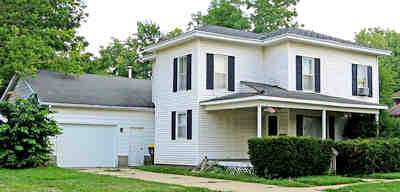
Can you tell us where this is located? Drop us a line at mail@sjindy.com.
605 E. McConnell
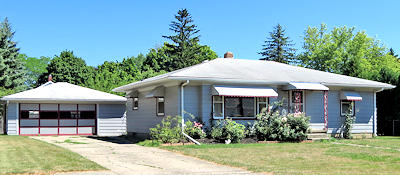
The current owners are Kathy and Ronald Patterson.
A Look Back – Sealed Power Open House in 1968
by Barry Clark Bauer
Over 800 persons toured the St. Johns plant of Sealed Power Corp. last Thursday evening as the local division observed its 20th anniversary here. Guided and semi-guided tours of the plant were featured, capped with refreshments.
The 20th anniversary celebration is actually a misnomer. The 20th anniversary actually came two years ago, but the plant was in the midst of a huge expansion program and the official observance was delayed.
Lawrence G. Sexton, plant manager, expressed the company’s gratitude for the fine turnout and interest in the local plant.
Bates bore operator, Kenneth Cramer, explains the functions of the huge Sealed Power Corp. equipment to visitors touring the St. Johns plant last Thursday evening during an open house in observance of the firm’s 20th anniversary in St. Johns. The Bates bore turns the inside diameter of the piston-rings the firm makes, and this is about the half-way stage of the ring through the processing at St. Johns.
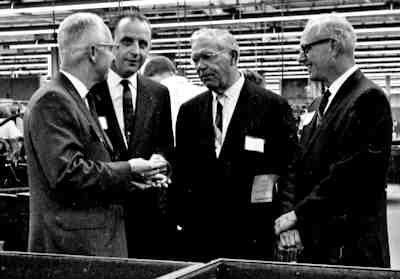
Lawrence Sexton left, plant manager of the St. Johns Division of Sealed Power Corp., chats with officials of the company during last Thursday evening’s open house observing the 20th anniversary of the plant in St. Johns. With Sexton are Warren Carter, vice-president for manufacturing;
Paul C. Johnson; chairman of the board of directors; and William Oliver, vice-president for industrial relations.
Sealed Power manufactures piston rings, pistons, cylinder sleeves and other related parts for the original equipment and replacement trades in the automotive field. Its annual sales are approximately $50 million.
The St. Johns Division of Sealed Power is devoted exclusively to the manufacture of piston rings, primarily for the larger engine builders of the country. The major share of the production here is shipped to General Motors, Ford, and Chrysler.
Since its establishment here, Sealed Power employment has increased from 35 to 232, and payrolls have increased 20-fold. The plant has had three major expansions, the last of which increased capacity by 75 per cent when completed in 1967.
Management personnel of the St. Johns division include Sexton as plant manager, Emil Flermoen as superintendent, Robert “Bob” Gill as personnel supervisor, Hugh Wallace as production and office supervisor, Charles Coletta as manufacturing engineer, Herman Bosma as plant engineer, Elston Hicks as maintenance foreman, Richard Wilson as process engineer, William Aldrich as tooling engineer, Stanley Smith as Inspection supervisor, Donald Messer as industrial engineer and Charles Rasdale as steel press engineer. Machine shop foremen include Dale Baker, Walter Baxter, Arden (Jack) Birdsley, John Fedewa, Charles Olson, Edgar Prowant, Stan Plaza and Roman Rademacher.
Sealed Power went through a couple of name changes; first they became Dana and currently is known as Mahle.
Random Notes – Hitching Post Restaurant to close August 10
By Rhonda Dedyne
When the Hitching Post Restaurant closes its doors on August 10, owner Shirley Henning says it will be “a day like every other day here – no special farewell celebration.” That may be true, but odds are good there will be a few tears shed along with lots of happy laughter as memories are exchanged from the past 53 years that Shirley and her family have operated the business on BR-127, a few miles north of St. Johns.
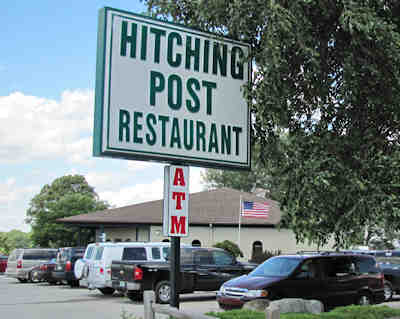
There’s no way of knowing how many satisfied customers have enjoyed the restaurant’s good food and conversation over the years, although Hitching Post “regulars” like Wanda Lockwood and Dixie Lee Kosloski believe it must be “many, many thousand.”
“Everybody knows the Hitching Post as a welcoming place where the food is great, the wait-staff is the best and the coffee is always on,” Lockwood says with a laugh while Kosloski smiles in agreement as they enjoy a cup of afternoon java with regulars and groups of travelers headed to or from Michigan’s “Up North” on family vacations.
Those vacationers will miss the Hitching Post as much as area residents. A multi-generational family from Detroit is a prime example. The group was saddened to learn this would be the final time the restaurant would be part of their vacation itinerary, Henning says. “They’ve been stopping to eat for years and the grandfather wanted to have the family’s picture taken when they were here recently so we did that for them.”
Travelers on the major north-south highway have been part of the Hitching Post’s history for more than a century. The original building was located slightly north and closer to the highway. That was torn down and the existing building was constructed in 1994 after Henning purchased the business from her father in 1981. “My dad, Richard Clandening, bought the business in 1963,” Henning says about her father who relocated to the St. Johns area from Fowlerville. “I was 12 years old when he and I moved here, so I’ve basically grown up in the business.”
The Hitching Post’s reputation revolves around a family-friendly menu where omelets and skillet meals are served all day, not just for breakfast. “Those are certainly among the favorites of our customers. I have no idea how many thousands of omelets and skillets we’ve served total,” Henning says.
Ditto for the number of people that have been employed there over the years. “We’ve been fortunate to have so many great people working here – some for more than 20 years – and I will truly miss them,” the owner says, citing one person as being particularly important. “My daughter, Melissa, grew up in the business like I did, and I’m so thankful for her help. It’s been special working with her.”
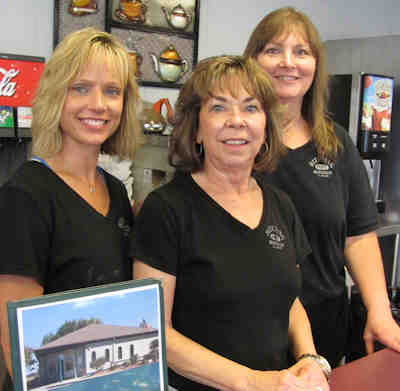
Shirley Henning and two members of the Hitching Post “family,” Robin Sample and Kristal Davis, are getting ready to say farewell to a St. Johns area restaurant landmark.
Henning’s employment of area residents and positive impact on the overall area has not gone unnoticed by Hitching Post patrons like Kosloski. “Shirley has done a lot for many people – she’s the best.”
Henning returns the compliment, thanking customers for their support and patronage. Still, after being on call seven days a week for all those years she’s ready for the next stage in life. “My husband Mike and I will probably travel a bit, but we don’t know for sure exactly what we will do. It will be a change for sure. We will miss our customers and our employees. We are like a family here.”
Letters – World War ll Memorial at City Park and thanks from District Library and SJPD
Has anyone else noticed that the World War ll Veteran’s Memorial that is just east of the spray park appears to be in need of some care. The area surrounding the memorial is vacant of any flowers (and the memorial is in need of a proper cleaning). There are flowers placed throughout the park areas (around the pavilion, the band shell etc.) but not around the memorial.
Although we have the downtown memorial, this original one holds special meaning in remembrance of our World War ll Veterans. Let’s not let it go!
Can we get a group together to take care of this in remembrance of what they did for our country and the world?
Judy Williams
******
Thank you to our patrons and the St. Johns community for your support!
The passage of this millage allows us to continue to serve you, while we plan for exciting changes in the future.
A special “thank you!” to the Briggs District Library staff, Library Board, and the YES Briggs Library committee for their hard work and dedication over the course of this campaign.
Briggs District Library Board
******
The St. Johns Police Department would like to thank the following local businesses and service groups for their generosity in donating toward National Night Out. We could not do it without their help!
– The St. Johns Kiwanis Club who cooked over the hot grills and also served the hotdogs and corn.
– The St. Johns Rotary Club who ran the kids games and inflatables.
– The St. Johns Lions Club who served the ice cream sandwiches.
– Big Boy Restaurant
– McDonalds of St. Johns
– Kroger of St. Johns
– Andy T’s Farm Market
– Planet X Inflatables
– Kombat Tag
– Harry Verellen /Bubble Soccer
– Sound Cruise DJ – Ed Hafner
– Sharon Shutes and Sara Koenigsknecht for the face painting
– Louis Longoria
– Martin Brower
– Olympian Tool
– RSI Home Improvement
– Mercantile Bank
– The Wheel Inn
– Journey Federal Credit Union
– The Sunshine Center
– Keck Coleman Funeral Home
– Bee’s Chevrolet for the use of a truck
– Kurt’s Appliance for the use of a freezer
– Burt Rentals for the use of tables
– Ralph Bailey/American Rentals for the porta-johns
– Jesse Ballard for the drone photos
– Maple Rapids Cub Scout Pack 519
– Clinton Area Ambulance Service
– St. Johns Fire Department
– St. Johns Department of Public Works
Maralyn’s Pet Corner – Breed of the Week
The Doberman Pinscher is a dog breed first developed in Germany as a guard dog. Once known to be aggressive, the Doberman’s temperament has improved through tactful breeding over the years and is now considered a reliable family pet.
Physical Characteristics

The Doberman’s powerful, muscular, compact, and square-proportioned build gives it speed, elegance, strength, and endurance. Its posture is alert and proud, while its gait is fast and loose. The accepted colors for the breed include black, red, blue, and fawn — a light yellowish brown. And its rust-colored markings are found above each eye, on the muzzle, throat and forechest, below the tail, and on all four legs and feet. The Doberman also sports a smooth, short coat with neat lines and a white patch on its chest.
Personality and Temperament
This adventurous and loyal companion is a talented and obedient pupil, always ready for a mental challenge. Though it’s usually sensitive and responsive to its owner’s commands, the Doberman can be dominating and overbearing. The breed is also shy with strangers, while aggressive towards strange dogs. A Doberman’s alertness and protection ability, however, are often the qualities sought after by dog fanciers.
Care
The Doberman requires mental and physical exertion daily or it may become destructive or frustrated. This need can be easily met with a walk on a leash, a run in an enclosed area, or a long jog. And while it can live outdoors in cool climate, the Doberman is most effective indoors as a guardian and a family companion. Its coat requires minimal care.
Health
The Doberman Pinscher has a lifespan of 10 to 12 years. Wobbler’s syndrome, cervical vertebral instability (CVI), and cardiomyopathy are some serious health problems affecting Dobermans; some minor diseases seen in this breed of dog include canine hip dysplasia (CHD), osteosarcoma, von Willebrand’s disease (vWD), demodicosis, and gastric torsion. Albinism, narcolepsy, hypothyroidism, and progressive retinal atrophy (PRA) are occasionally seen in Dobermans, while the Blue Doberman is more prone to hair loss. To identify some of these issues, a veterinarian may run cardiac, eye, hip, and DNA tests.
History and Background
Louis Dobermann, a German tax collector, is credited for the creation of the Doberman Pinscher. In search of a watchful guard dog to accompany him during his rounds, Dobermann developed the Doberman Pinscher in the late 19th century by crossing the old German shorthaired shepherd and the German Pinscher. Later the Black and Tan Manchester Terrier, Weimaraner, and Greyhound were also crossbred.
The original Dobermans had round heads and heavy boned bodies, but breeders soon developed a more robust-looking dog. Over time, the breed evolved remarkably and by 1899, the National Dobermann Pinscher Club, the first club for the new breed, was created in Germany.
After attracting much fame, the first Doberman was introduced to the United States in 1908. The Doberman was used as a guard dog, police dog and even as a war dog, all qualities that eventually made it a favorite as a family protector. Its chiseled outline also made the Doberman a popular show dog.
A new challenge for the breed would arise in the 1970s — the emergence of the albinistic white Doberman. With this albino gene came a wide range of serious health conditions. In an effort to remedy this problem, the Doberman Pinscher Club of America convinced the American Kennel Club to tag the registration numbers of dogs susceptible to the albino gene with the letter “Z.”
In 1977, the Doberman became the second most popular breed in the United States. Since then, the breed has kept its well-regarded status as both a guard dog and a family pet.